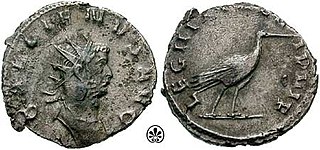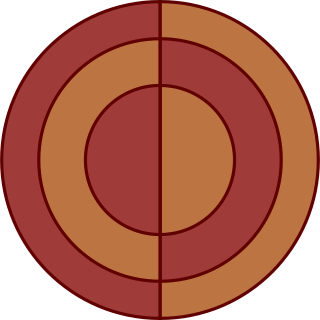
Legio decima Gemina, was a legion of the Imperial Roman army. It was one of the four legions used by Julius Caesar in 58 BC, for his invasion of Gaul. There are still records of the X Gemina in Vienna in the beginning of the 5th century. The legion symbol was a bull. Early on in its history, the legion was called X Equestris (mounted), because Caesar once used the legionaries as cavalry.

Legio tertia decima Geminia, in English the 13th Twin Legion, also known as Legio tertia decima Gemina, was a legion of the Imperial Roman army. It was one of Julius Caesar's key units in Gaul and in the civil war, and was the legion with which he famously crossed the Rubicon on January 10, 49 BC. The legion appears to have still been in existence in the 5th century AD. Its symbol was the lion.

Legio tertia Italica was a legion of the Imperial Roman army founded in AD 165 by the emperor Marcus Aurelius, for his campaign against the Marcomanni tribe. The cognomen Italica suggests that the legion's original recruits were mainly drawn from Italy. The legion was still active in Raetia and other provinces in the early 5th century.

The Jovians and Herculians were the senior palatine imperial guard units under the rule of Diocletian. They continued in existence thereafter as senior units in the field armies of the Western and Eastern Roman Empires.

Dux Britanniarum was a military post in Roman Britain, probably created by Diocletian or Constantine I during the late third or early fourth century. The Dux was a senior officer in the late Roman army of the West in Britain. It is listed in the Notitia Dignitatum as being one of the three commands in Britain, along with the Comes Britanniarum and Count of the Saxon Shore.

Legio quinta Macedonica was a Roman legion. It was probably originally levied in 43 BC by consul Gaius Vibius Pansa Caetronianus and Gaius Iulius Caesar Octavianus. It was based in the Balkan provinces of Macedonia, Moesia and Dacia. In the Notitia Dignitatum records from beginning of the fifth century, the legion was still stationed in Dacia, with detachments stationed in the east and Egypt.

The Legio I Maximiana was a comitatensis Roman legion, probably created in the year 296 or 297 by the Emperor Diocletian.

The Legio II Flavia Constantia was a comitatensis Roman legion, created by Diocletian, probably in the year 296 or 297.

Legio V Iovia was a Roman legion levied by Diocletian in the end of the 3rd century, and was still in service at the beginning of the 5th century. The cognomen of the legion refers to Jupiter, to whom Diocletian was devoted and identified.
Consularis is a Latin adjective indicating something pertaining to the consular office. In Ancient Rome it was a title given to those senators who held consular rank, i.e. who had served as consuls or who had received the rank as a special honour. In Late Antiquity, the title became also a gubernatorial rank for provincial governors.
Legio II Isaura was a pseudocomitatensis Roman legion, levied no later than under Diocletian, and possibly already present under Probus. As their name suggests, II Isaura and its twin legion III Isaura were guarding the Isauria territory at the time of the Notitia Dignitatum, to defend it from the incursions of the mountain peoples. It is possible that in the beginning they were supported by I Isaura Sagittaria. According to Ammianus Marcellinus, in 360, they were stationed in Bezabde with II Armeniaca, and II Parthica, when the king of Persia, Shapur II besieged and conquered the city, killing many of the inhabitants.

Legio I Isaura Sagitaria was a pseudocomitatensis Roman legion, levied no later than under Diocletian, and possibly already present under Probus. As its name suggests, its legionaries could be used also as archers, an uncommon feature for Roman legions.
Legio I Iovia was a Roman legion, levied by Emperor Diocletian (284–305), possibly together with II Herculia, to guard the newly created province of Scythia Minor. The cognomen of this legion came from Diocletian's attribute Iovianus, "similar to Jupiter".
Legio II Herculia was a Roman legion, levied by Emperor Diocletian (284–305), possibly together with I Iovia, to guard the newly created province of Scythia Minor. It was stationed at Capidava. The cognomen of this legion came from Herculius, the attribute of Maximian meaning "similar to Hercules".
Publius Aelianus Aelianus was a senior officer in the Imperial Roman army in the mid-Third Century AD who rose from relatively lowly origins to become the prefect of a legion under the Emperor Gallienus He was one of the earliest beneficiaries of Gallienus's policy that effectively excluded senators from army commands in favour of career-soldiers of equestrian rank. His later life is obscure.
The Legio IV Italica was a legion of the Imperial Roman army raised in AD 231 by emperor Alexander Severus. The legion remained in existence as late as AD 400.

Moesia Prima was a frontier province of the late Roman Empire, situated in the central parts of present-day Serbia, along the south bank of the Danube River. Provincial capital was Viminacium, near modern Kostolac in Serbia).

Osroene, also spelled Osrohene and Osrhoene, was a Roman province which existed for nearly 400 years. It was formed after the absorption of the Kingdom of Osroene in 244 CE and served as a frontier province against the Sassanid empire until the Muslim conquests of the 7th century.











